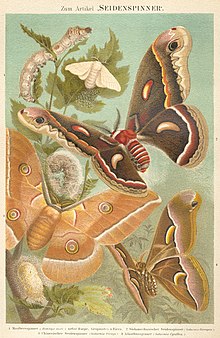
Back Sy Afrikaans Seide ALS Sīde ANG حرير Arabic ৰেচম Assamese Seda AST İpək Azerbaijani ایپک AZB Ебәк Bashkir Sėlks BAT-SMG
| Silk | |
|---|---|
 "Silk" in seal script (top), Traditional (middle), and Simplified (bottom) Chinese | |
| Chinese name | |
| Traditional Chinese | 絲 |
| Simplified Chinese | 丝 |
| Vietnamese name | |
| Vietnamese alphabet | lụa |
| Chữ Nôm | 縷 |
| Japanese name | |
| Kanji | 絹 |
| Kana | きぬ |

Bombyx mori, Hyalophora cecropia, Antheraea pernyi, Samia cynthia.
From Meyers Konversations-Lexikon (1885–1892)
Silk is a natural protein fiber, some forms of which can be woven into textiles. The protein fiber of silk is composed mainly of fibroin and is produced by certain insect larvae to form cocoons.[1] The best-known silk is obtained from the cocoons of the larvae of the mulberry silkworm Bombyx mori reared in captivity (sericulture). The shimmering appearance of silk is due to the triangular prism-like structure of the silk fibre, which allows silk cloth to refract incoming light at different angles, thus producing different colors.
Silk is produced by several insects; but, generally, only the silk of moth caterpillars has been used for textile manufacturing. There has been some research into other types of silk, which differ at the molecular level.[2] Silk is mainly produced by the larvae of insects undergoing complete metamorphosis, but some insects, such as webspinners and raspy crickets, produce silk throughout their lives.[3] Silk production also occurs in hymenoptera (bees, wasps, and ants), silverfish, caddisflies, mayflies, thrips, leafhoppers, beetles, lacewings, fleas, flies, and midges.[2] Other types of arthropods produce silk, most notably various arachnids, such as spiders.
- ^ "Silk". The Free Dictionary By Farlex. Archived from the original on 3 July 2021. Retrieved 23 May 2012.
- ^ a b Sutherland TD, Young JH, Weisman S, Hayashi CY, Merritt DJ (2010). "Insect silk: one name, many materials". Annual Review of Entomology. 55: 171–88. doi:10.1146/annurev-ento-112408-085401. PMID 19728833.
- ^ Walker AA, Weisman S, Church JS, Merritt DJ, Mudie ST, Sutherland TD (2012). "Silk from Crickets: A New Twist on Spinning". PLOS ONE. 7 (2): e30408. Bibcode:2012PLoSO...730408W. doi:10.1371/journal.pone.0030408. PMC 3280245. PMID 22355311.